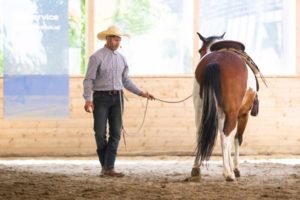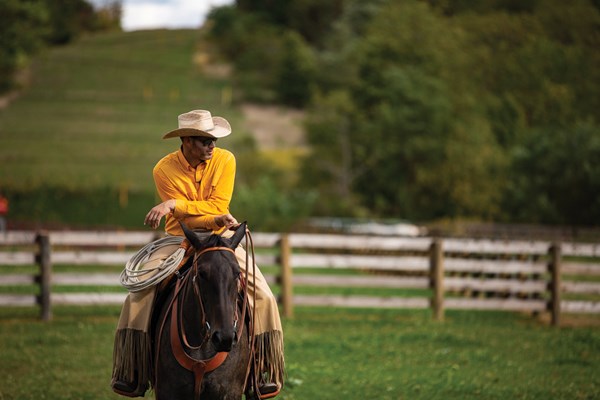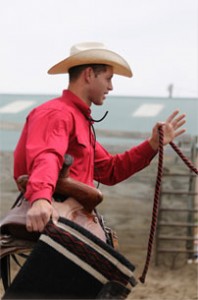Eclectic Horseman March Issue
Focusing on the Hindquarters By Cal Middleton
 Gaining control of the hindquarters may be the single most important goal when working and riding a horse. What does it mean? Why is it so important? How do we achieve it? Those are the questions I’ll be answering in this 3-part series of articles. This year, more than most, I have been on the road traveling, learning and teaching, and I see mostly the same issue everywhere I go. Explaining the issue is simple. Not having proper control of the hindquarters. This is the beginning or the end of all we ever ask or allow of our horse.
Gaining control of the hindquarters may be the single most important goal when working and riding a horse. What does it mean? Why is it so important? How do we achieve it? Those are the questions I’ll be answering in this 3-part series of articles. This year, more than most, I have been on the road traveling, learning and teaching, and I see mostly the same issue everywhere I go. Explaining the issue is simple. Not having proper control of the hindquarters. This is the beginning or the end of all we ever ask or allow of our horse.
Subscribe today to receive this issue:
https://

Eclectic Horseman Jan Issue
Why the Hindquarters Are So Important By Cal Middleton
The reason that gaining control of the hindquarters is so important is not only because this is where the balance and all the power begins and ends in a horse but more importantly because it’s the largest part of the body that controls the defensiveness of the horse. It’s the physical manifestation of the horse’s mind. When the horse feels as if she needs to defend herself, the first thing that happens is the hindquarters tighten up.
Subscribe today to receive this issue: https://
Horse & Rider
Control His Feet to Be a More Confident, Effective Rider
- CAL MIDDLETON, WITH J. FORSBERG MEYER
- Control of your horse is what makes you a confident, effective rider. To gain that control, you have to be able to direct the movement of his feet, because they dictate where and how fast he goes. Yes, his brain controls his feet, but his feet are what carry out the movement.
[BUILD CONFIDENCE: A ‘WHOA’ YOU CAN TRUST]
It’s a little like the importance of tires in maneuvering a truck. Yes, the steering wheel is critical, but if it isn’t connected to the tires, you can steer all you want and the truck will still go into the ditch.
Similarly, without that all-important connection between your hands and your horse’s feet, you can’t fully control where he goes.
In particular, it’s the hind feet you want influence over, because they’re his “engine.” This exercise will connect your right hand to your horse’s right hind foot, and your left hand to his left hind, giving you maximum control over his movement.
Having this basic control of the hindquarters is the single most important thing you need in riding, as it’s the foundation of every advanced move you’ll ask of your horse going forward.
Defining Control

Use one rein to tip your horse’s nose slightly to the side—see my right rein, here. Cal Middleton
Use one rein to tip your horse’s nose slightly to the side—see my right rein, here.
“Control” doesn’t mean being aggressive or dominating. It means influencing your horse to willingly give you the say over his feet because he trusts you.
This exercise, performed in both directions, will condition your horse to understand that when you pick up on the right rein, his right hind foot moves to the left, followed by the left hind foot, which in turn removes any bracing or tightness from the hindquarters.
And vice versa with the left rein. It becomes an automatic response that both you and he can rely on.
How to Do It
I’ll describe connecting your right rein to his right hind foot; to do the same on the left, simply reverse all cues.
[BUILD CONFIDENCE: MASTER TRANSITIONS]
Get your horse moving forward at a brisk walk. Slide your right hand down the right rein, then draw it back toward your right hip bone. Your goal is to tip your horse’s nose slightly to the right, without really bending his neck, such that you can just see his right eye. (Support with your left rein as needed to keep him from pushing forward.)
His poll should be slightly flexed, and both his eye and his ear should “look down” the right rein.
His right hind foot should simultaneously step to the left, crossing over in front of his left hind. Try to avoid using your leg; you want his response to come from your hand.

Refine It
Practice this exercise in both directions and in different scenarios. For example, in addition to using it to stop from a walk, use it simply to slow the walk down without coming to a full stop.
You can also use it to start downward transitions from trot to walk and, later, from lope to trot.
Once you have full control of both sides of his hindquarters, you’ll be able to pick up on both reins at the same time and expect your horse to give both sides simultaneously—that is, to come to a stop without stepping to the side. In that way, you’ve also reinforced your stop cue. Which boosts your confidence, as well.

